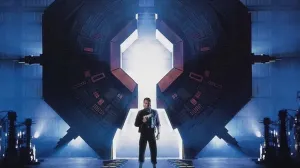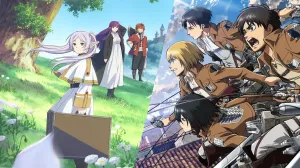There appears to be no end to the inventive new ways The Tick creator Ben Edlund and Hollywood producer Barry Josephson can reinvent and refresh the satiric superhero.
Videos by ComicBook.com
First there was Edlund’s comic book series that adroitly sent up the superheroic tropes of its ’80s-era contemporaries; next came the profoundly sublime smarter-than-Saturday-morning-fare animated series of the ’90s that endeared the character to mainstream audiences, followed by the cult-beloved but criminally underwatched primetime live-action series of the 2000s starring Patrick Warburton. And now, with the second half of the critically praised debut season of Amazon‘s live-action take on the antennaed ace’s adventures premiering today, February 23rd, the duo once again prove that they can adeptly re-jigger Edlund’s comedic creation for a new format and a new era.
Edlund – a seasoned screenwriter outside of comics and the primary scribe behind the new series – and Josephs, whose canny eye for properties has produced mega-hits like Men in Black and Bones, joined ComicBook.com for a look at where the series goes from here, and how The Tick and Arthur get deeper without missing a laugh.

ComicBook.com: These episodes are of a piece, production-wise, with the original six, but every show learns on the fly in that first season. What were the lessons that you learned early on in production, that you can sort of know are reflected in these episodes?
Ben Edlund: We’ve learned so much.
Barry Josephson: We were just talking about this before, we so enjoyed Danger Boat, that we wanted to really play Danger Boat this back half of the season. We really liked that environment. We liked Overkill’s relationship to it. Ben really leaned into a relationship that Danger Boat has with Arthur, with Dot. I think we just really, for the second half of the season, we’re thinking, “Filming that at first feels like this works. That’s a good environment.” That was one thing.
I think also just the idea of the growth of Tick and Arthur’s relationship, sort of felt like it was playing so well in the first half in action and in supportive relationship, and how they work together. The two actors, in that first half of the season, we would look at dailies and look at their work and be on set and think, “This is just great.” We felt confident about that playing out too. The interrelationship of the actors and how they worked as an ensemble was great.
It just felt like our ensemble was functioning and working, and the terror felt great, and Miss Lint, and it was just growing and working. Going into the second half of the season was exciting for us. We thought, “This cast is just clicking.”
Edlund: I think that a lot of it was just the practice allowing for greater and greater flow on that level. The other thing was learning what we could and couldn’t do. Learning limitations, pretty important, and that’s something we’re still engineering. This is so much about engineering.
I’d say that yeah, first seasons are hell on earth, in a sense. They’re designed to … I mean they’re not designed! First seasons, it’s the best reaction you can possibly have: someone says, “Make a show,” and then you react and then you’re done. I’d say that we really did, we learned that we could do it, which was, that was a lot to learn.
Josephson: The back half of a season, I mean that’s hard, because you set up so much that you’re headed towards and you’re like, “Oh my God, I hope we don’t hit a brick wall. I hope it works out.”
Edlund: The land of Spruce Goose.
You mentioned the growth of that relationship between the Tick and Arthur, and that’s something that is special to this show, in ways that you haven’t had to do it quite at the pace that a show like this is going to ask you to, like in the comics or in animation. Tell me a little bit about that: knowing all the math that there is that goes into making a Tick project, and sort of rewriting the math for this particular show, and how these characters can grow a little bit – but not “too” much. That fascinates me.
Josephson: There were certain scripts when I would read what Ben wanted to do, and you think, “Oh my God, this is going to be challenging.” It’s one thing to have a talking dog on a talk show, and now the talking dog’s out in the world, and now the talking dog’s having a fight with Overkill. You read the scripts and you go, “God, I love that script!” You wake up the next morning, “How are we doing that? How are we changing the size of one of the characters and how are we playing that? How will that play? How do we design for that?” And so on.
Really interesting challenges, and for our directors too, stepping in and realizing you have seven days of execution, that’s it. It’s not a big, long movie, where it’s like, “I’ll worry about that next week.” It’s every day is this new challenge of production. I have to say, if you look at the back half of The Tick, the production certainly grew, and I think some of the challenges grew. It was just remarkable and really great to experience it, and our post-production too.
Last thing I’ll say to answer that question, is that Ben is not just a great creator of script, but in post-production, when he sees a show cut together, some invention happens then that’s really important to the show, and really pays off in the back half of the season.
Edlund: I think in terms of the writing, we definitely, in this version, needed to pace out Arthur’s development as a hero. It took time, because we want to care about whether or not he’s able to be one. In the earlier iterations, he basically in the pilot said, “This is what I’m doing. Don’t anybody ask any questions. I’m going to be a hero,” because we need somebody to do that, because we’re starting to show.
That was essentially his psychological truth, but here, in order to get these guys, the Tick is really a mentor. He really needs to be a person who needs that, and Arthur. The Tick is really a partial intelligence. He’s some kind of Oliver Sachs, guy-who-mistook-his-wife-for-a-hat thing, and he needs a friend to kind of show him where his compass gives out. That relationship is, we’ve never taken it I think more seriously or gotten more into how they complete each other than this time.
Ben, there were the comic book superhero tropes you were able to play off of in the beginning when you invented the character for the page, and then you could kind of tweak that for animation, and those familiar tropes in that particular genre. Now with the proliferation of all the superhero product that’s out there, everybody’s familiar with some version of superhero storytelling. How has that changed the way you look at the show and the character now, and the things you want to satirize and send up?
Edlund: It means that what we can choose to satirize, it’s a larger menu of choices because the audience is naturally better educated, so we can actually point at certain aspects of superhero culture and people will understand that, that is an aspect of superhero culture. That gives us a better place to start with just the gags, the humor. I mean, I think that puts us in a very good position.
What’s weird is the comic book started out in, I started working on it in ’86, became fixated with what was in comics at that time, which was Frank Miller’s Daredevil. Then we start this, it’s Netflix’s Daredevil. We’re still doing Daredevil! Like, one of the key things I was looking at was Netflix’s Daredevil, because that was the first expression of the new. Netflix is one of the four corners of our superhero kind of zeitgeist now. It’s just very interesting to me that I was making fun of Superman and Daredevil in the beginning of The Tick, and that’s what we’re doing now. Really, no progress has been made. Just zero progress!
Tone is the trickiest thing for any project. The tone that you guys hit here is so specific. I feel like it’s in the tradition of that straight-faced send up stuff that Adam West was doing, but it also is a degree away from what we see on The CW kinds of shows, too – people who like those shows can take this show semi-seriously, too. Tell me about finding that kind of perfect sweet spot of keeping it light, keeping it funny, but keeping people invested in the story that you’re telling.
Edlund: That’s hard. That’s tough. That was always the hardest. Tone was the word we used the most in developing this. We would just non-stop discuss where tonally we were and where we wanted to be.
I think that a breakthrough came because Barry was very much a staunch defender of this way, too – specifically the Arthur flashback scene in the pilot, where his dad goes across the street and gets just crushed, but also gets crushed and he’s just playing with the same toy. It’s just ridiculous. It’s just very dumb. Then the bad man comes out of another spaceship and eats Arthur’s ice cream. The whole thing is dumb and very stupid, and very heartfelt and very much about real trauma. You feel for this boy.
Josephson: You need to experience it.
Edlund: Kyle was a really good actor. You feel this is a horrible thing, but it is dumb. That’s, for us, the codex of tone, that you can actually be as dumb as that, and somehow be emotionally solid at the same time. Tone was very, very difficult.
Josephson: Yeah, tone’s very important. I think I had just come, when I met Ben, I had just finished having worked on Men in Black, where I had optioned that comic and saw it come to fruition as a movie. I met Ben right at that time. I learned a great lesson from the tone of that show, that movie. If you look at the group of people, the recruits who test in Men In Black, it’s the silliest scene ever. It’s broken pencils and silly sort of–
Edlund: –egg chairs!
Josephson: Yes, and silly fake aliens and so on, but it is just so “funny”. They walk into a coffee clatch of aliens, and that’s funny. I think the sort of tone worked. You were gripped by some of the realities of that. When I go onto this, and I would read “The Tick”, I really identified with Arthur. I really felt it was earnest and real, that he would want this, but not want that. That plays out so well, I think, in this season. He finally takes a breath and can accept the Tick.








